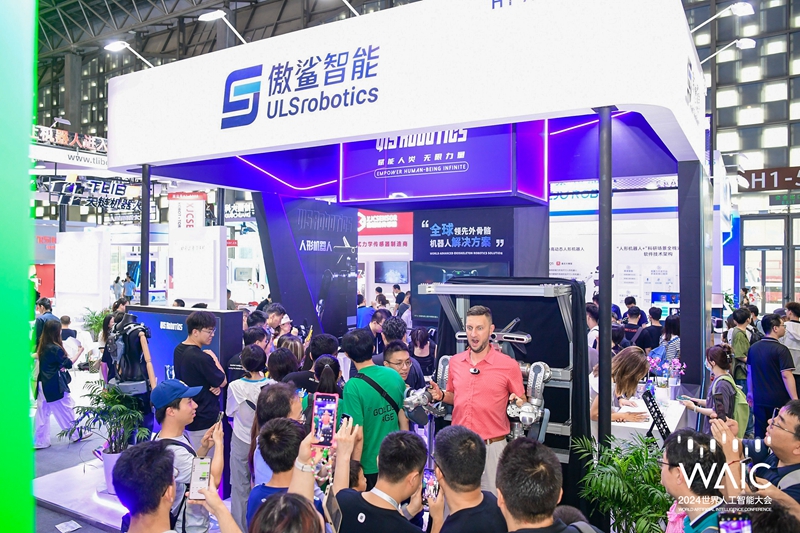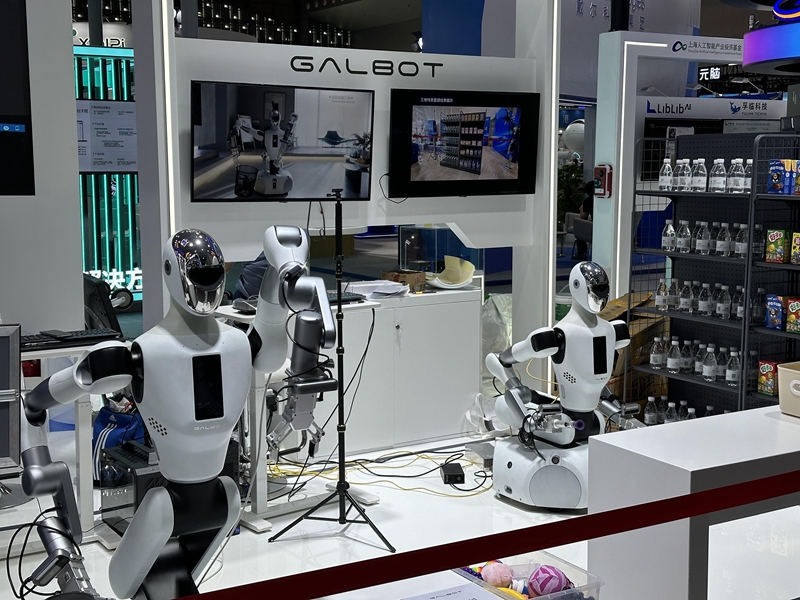The company focuses on developing robots with embodied artificial intelligence (EAI) for industrial production and daily use. While traditional AI operates solely in the digital realm, EAI integrates digital AI and real-world applications, which enables robots to move, see, and speak or interact with humans.
Galbot, 173 cm tall, has a chassis that rotates 360 degrees. It can extend to reach a height of 2.4 meters, and also squat to perform tasks on the ground. It's an EAI robot, a kind of humanoid robots.
"Equipped with a system for sensing the environment and carrying out human commands, Galbot can identify specific items of different shapes or materials, autonomously navigate itself to the items and grasp them," Zhu Hui, Product Director at Galbot, told Beijing Review, adding that the robot searched for and picked up items from racks for hundreds of visitors at the WAIC, with 95-percent accuracy.
According to Zhu, Galbot is poised to be applied in fields including automobile manufacturing and in retail applications such as contactless supermarkets. It is also exploring application of the robots in logistics and agriculture.
Chinese robotics companies are exploring new applications for their technologies in settings ranging from factories to family homes. According to the National Bureau of Statistics, China produced 430,000 industrial robots in 2023, exceeding 400,000 for a second year in a row. It also produced more than 7.83 million service robots, up 23.3 percent from the previous year.
Last year, China installed 290,000 new industrial robots, accounting for more than half of the world's total, according to the International Federation of Robotics.
"The development of China's robotics industry can be attributed to the Chinese Government's policy support and the progress of independent research and development (R&D). The boom of AI and machine learning also brings infinite possibilities to the robotics industry," Zhu said.
Diverse scenarios
Feel like a cup of coffee? Founded in 2019, Beijing-based tech company inSpace has been exploring the integration of AI and the Internet of Things. It has introduced Xbot, a coffee robot, for efficient coffee service in diverse scenarios. Over 70 percent of employees at inSpace work on R&D.
"Xbot can make a latte art pattern in 75 seconds and produce over 300 cups of coffee in eight hours. Over 300 Xbots have been launched across the globe," Tang Mu, Founder & CEO of inSpace, told Beijing Review, adding that the robot has started operating in several shopping malls and cafes in China, as well as the Republic of Korea, Australia and Canada.
According to Tang, Xbot can offer customers several choices. Its AI functionality allows it to watch, learn from and imitate human baristas. The company has also designed robotic arms for Xbot to imitate human hands for creating latte art patterns and holding cups.
The company is expanding the business by beginning to make robots for more purposes, including ice cream, and making Xbot smarter and more user-friendly.
Tang is upbeat about the coffee robots market. According to him, demand for smart service robots will continue to grow as people pursue a better quality of life. "Xbot will see wider application in restaurants, hotels and tourist sites, especially in overseas markets in the next few years," he said.
Chinese industrial robot producers are also moving to bridge the gap with established players in Japan, Germany and the United States, supporting the upgrading of China's manufacturing industries with growing impetus.
The production line of Shanghai STEP Electric Corp., founded in 1995, presents a futuristic scene. Its smart factory for robots began operation in 2020, and is the first factory in Shanghai where robots make robots.
According to the company, the assembly, welding and testing of components are almost all completed by robots. The process only requires nine staff members, who monitor the operation of the assembly lines and complete some supplementary manual labor.
In STEP's Shanghai mega-factory, a robot is assembled in just 12 minutes. The annual production capacity of industrial robots has exceeded 20,000 in recent years. Applications for the robots include automotive, new-energy and consumer electronics industries, a representative of STEP told newspaper Workers' Daily.

A visitor tests exoskeleton robotic devices from ULS Robotics at the 2024 World Artificial Intelligence Conference in Shanghai on July 6 (COURTESY PHOTO)
Shape shifters
Established in Shanghai in 2018, ULS Robotics also participated in this year's WAIC. The company focuses on developing exoskeleton robotic devices which can help users lift heavy objects using less strength to reduce fatigue and occupational injuries and increase productivity.
According to ULS Robotics, its products target labor-intensive industries including mining, logistics and electricity production, as well as virtual reality gaming and elderly care, helping cut over 60 percent of the physical stress on wearers. Its exoskeleton robotic devices have been applied in airports in China, including by baggage handlers at Beijing Daxing International Airport. More than 95 percent of its systems and technologies were developed in-house by the company.
ULS Robotics showcased its exoskeleton robots, including its ETH 01 humanoid exoskeleton robot, at the conference. "The ETH 01 is able to carry items weighing up to 40 kg and moves flexibly with 27 joints. Empowered by AI, it learns continuously to improve its functions," Zhang Hua, cofounder of ULS Robotics, told Beijing Review. He said the company has also produced devices to be worn on users' arms that weigh as little as 2.5 kg and provide an extra 5-10 kg of carrying capacity.
ULS Robotics is working on making its products more affordable and easier to wear for seniors and people undergoing medical treatment. The company projects the devices will be widely applied in elderly care in the next three to five years.
Chinese researchers are also working on small but flexible robots. In 2017, the Southern University of Science and Technology in Shenzhen, Guangdong Province, launched its Robotics Research Institute. A team led by Dai Jiansheng, president of the institute, has introduced robots with that resemble animals in shape, including crabs and dogs.
"The highly adaptable robots will be applied in fields including emergency rescue, agriculture and elderly care. Our team is also working on underwater, humanoid and industrial robots," Dai told Beijing Review.
The robots can shift shapes to get through narrow spaces to help perform tasks such as search and rescue undertakings, fire safety inspections and water quality testing, Dai said.
"As robots develop with smarter brains, and become more adept at shifting shape, the Transformers animated series, in which the robotic beings take on different shapes, might become a reality," he said.
Mimicking humans
Humanoid robots integrating EAI, high-end manufacturing and new materials are able to perform more diverse and complicated tasks than other robots.
Chinese robot companies are racing to tap into the humanoid robot market and make the robots smarter. According to Zhu, their company has developed systems independently for Galbot to receive human orders, give flexible responses and review its own performance. It has trained Galbot through using simulated synthetic data instead of data from real life. That makes the robot adaptable to different environments rather than being limited to specific real scenarios and versatile.
Earlier this year, Galbot and Peking University jointly established a laboratory dedicated to EAI in Beijing. The university focuses on R&D, while Galbot provides funding and proposes application plans.
According to Zhu, domestic humanoid robots are mostly in the initial phase of R&D. Galbot is also learning more skills. "It will take some time for Galbot to perform complicated household chores," he said.
At the WAIC, the Shanghai-based National and Local Co-Built Humanoid Robotics Innovation Center introduced its full-size generalist humanoid robot named Qinglong, the first of its kind in China.
The robot can walk fast, avoid obstacles and walk up and down slopes, allowing it to be used in diverse scenarios. The center has released models used for training Qinglong to share with other robotics companies.
Lifelike humanoid robots are becoming more popular. Ex-Robots, a company based in Dalian, Liaoning Province, has introduced humanoid robot Xiaoqi, which has the appearance of a human woman dressed in cyberpunk style. Empowered by AI, the robot can make facial expressions when answering questions, such as winking and frowning.
According to the company, it produces 400 to 500 robots a year, which are mainly used in museums, exhibition halls and tourist attractions.
Future outlook
The Chinese authorities pay special attention to the humanoid robot industry. According to a guideline issued by the Ministry of Industry and Information Technology in late 2023, China will strive to establish a preliminary innovation system for humanoid robots by 2025.
According to a report released by Beijing-based CCID Consulting this year, China's humanoid robot industry has entered a period of explosive growth since 2023 and is expected to reach a scale of 20 billion yuan ($2.75 billion) by 2026.
The report said that China has seen an increase in applications for patents relating to humanoid robots in recent years. Some regions, including Guangdong, Beijing and Shanghai, are now home to clusters of core robotics companies.
But the report also showed that the industry in China still faces challenges, and researchers and manufacturers need to improve R&D on key components, and enhance the ability of robots to interact with humans and their adaptability to different environments. High costs, difficulties in maintenance and human safety are issues that need to be addressed.
Research institutes and firms should strengthen cooperation in working toward the mass production and wide commercial use of humanoid robots, the report said.
















